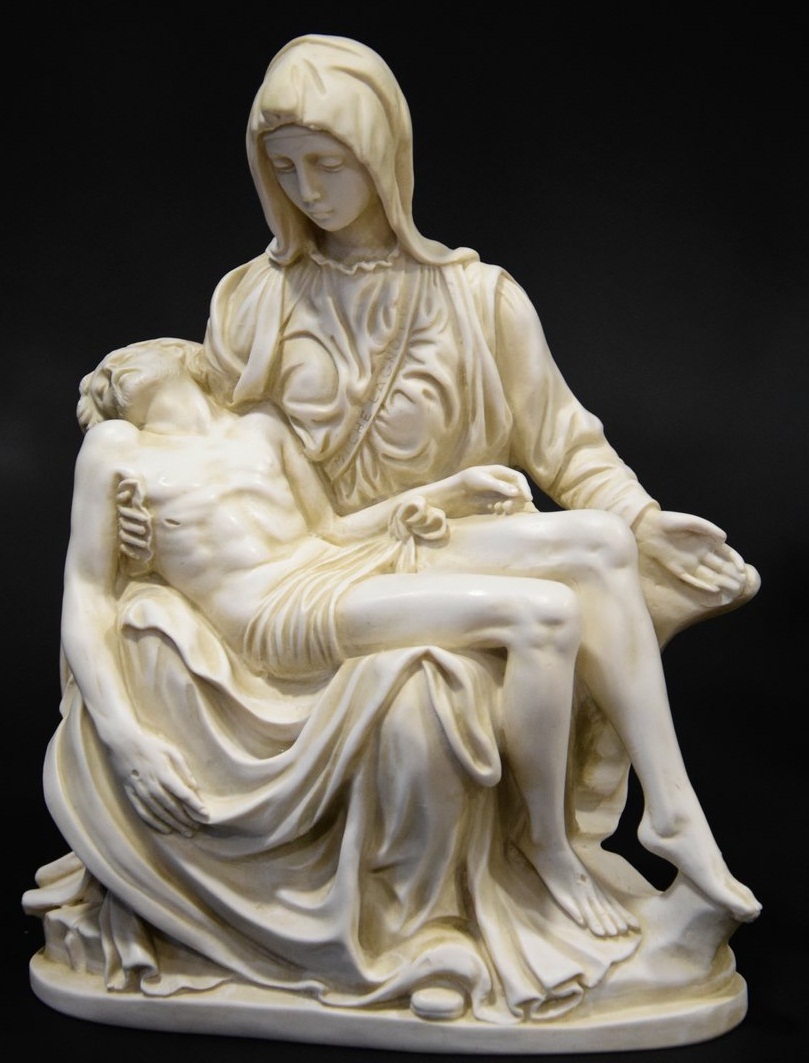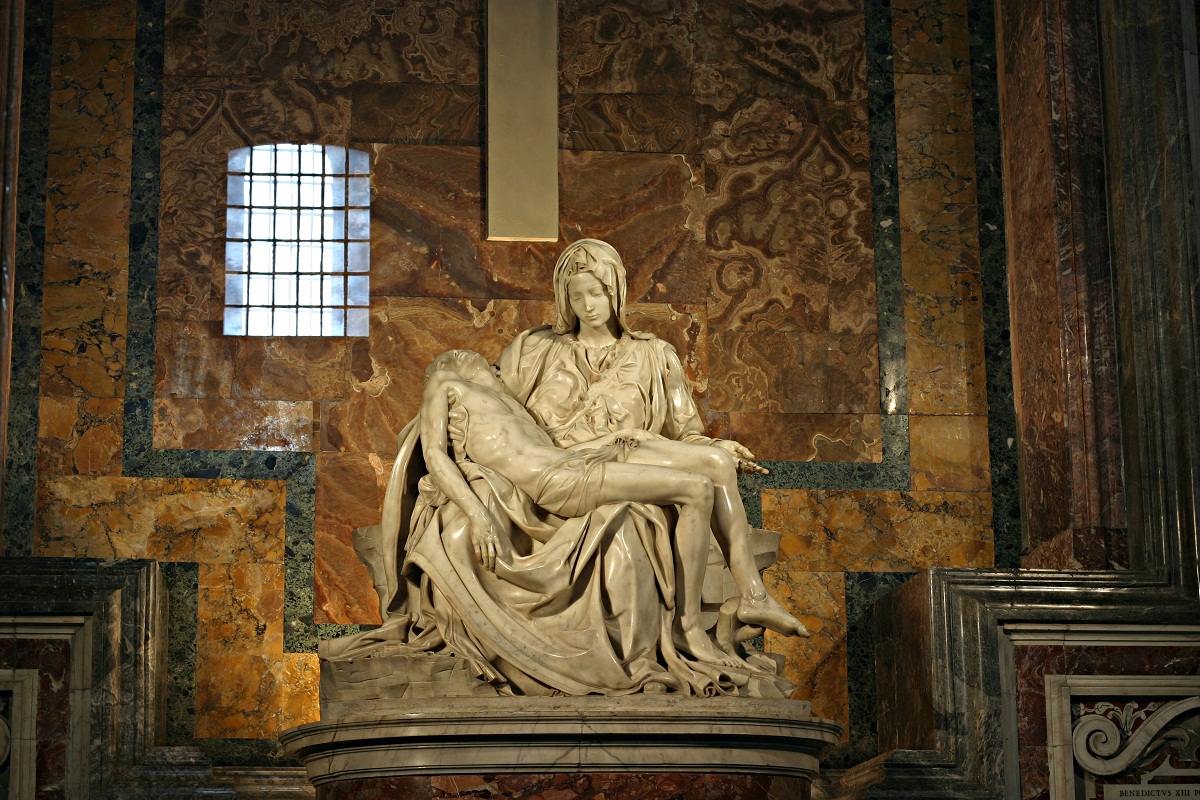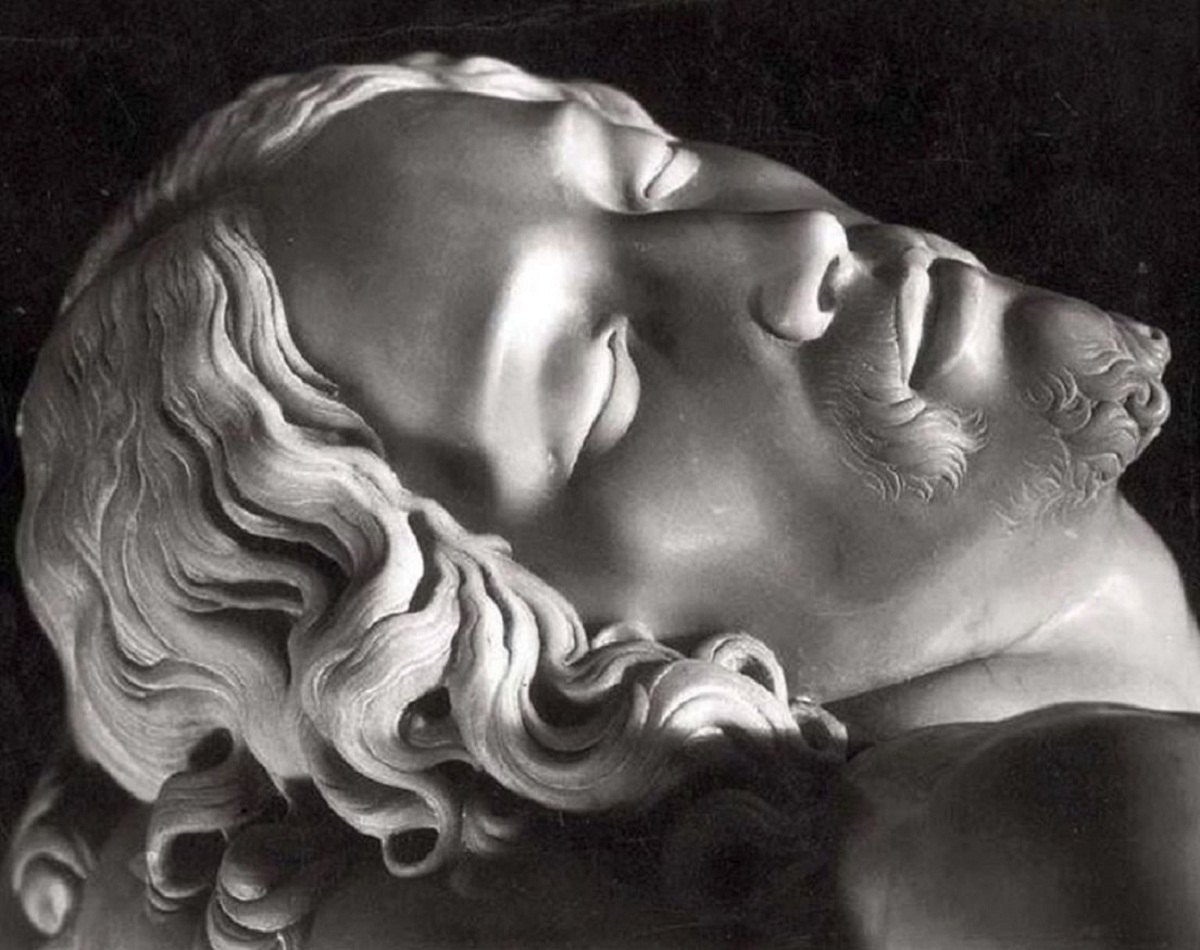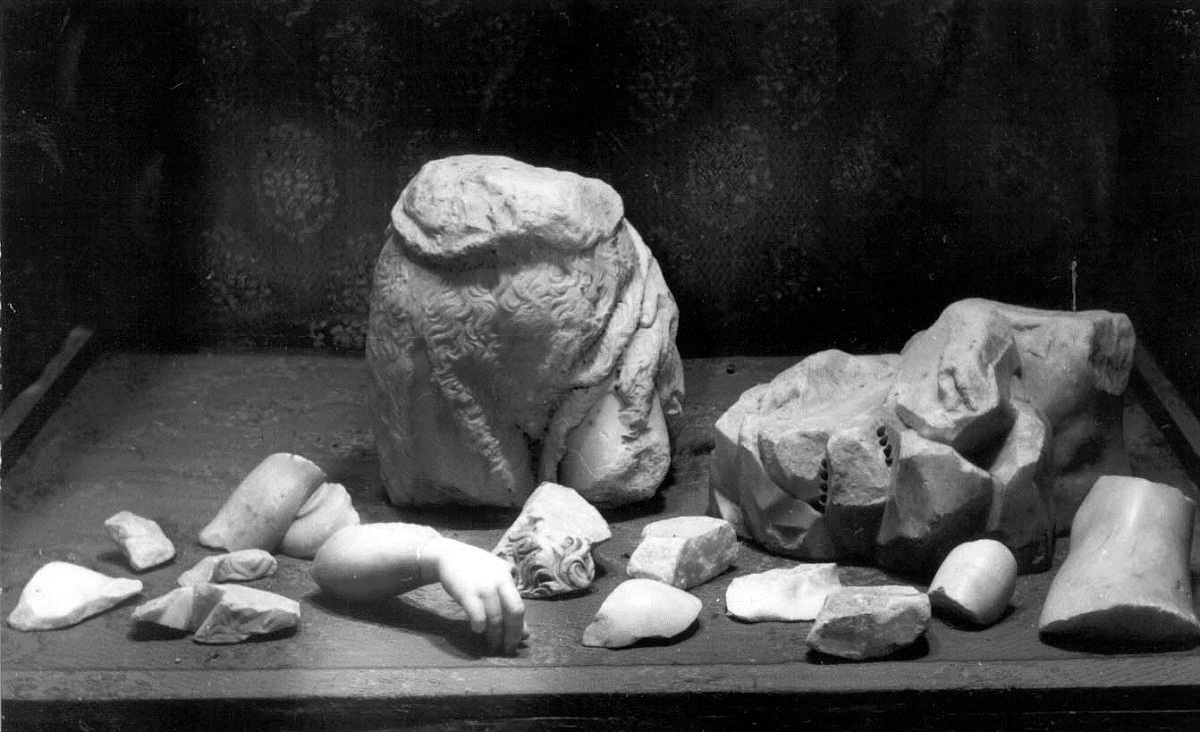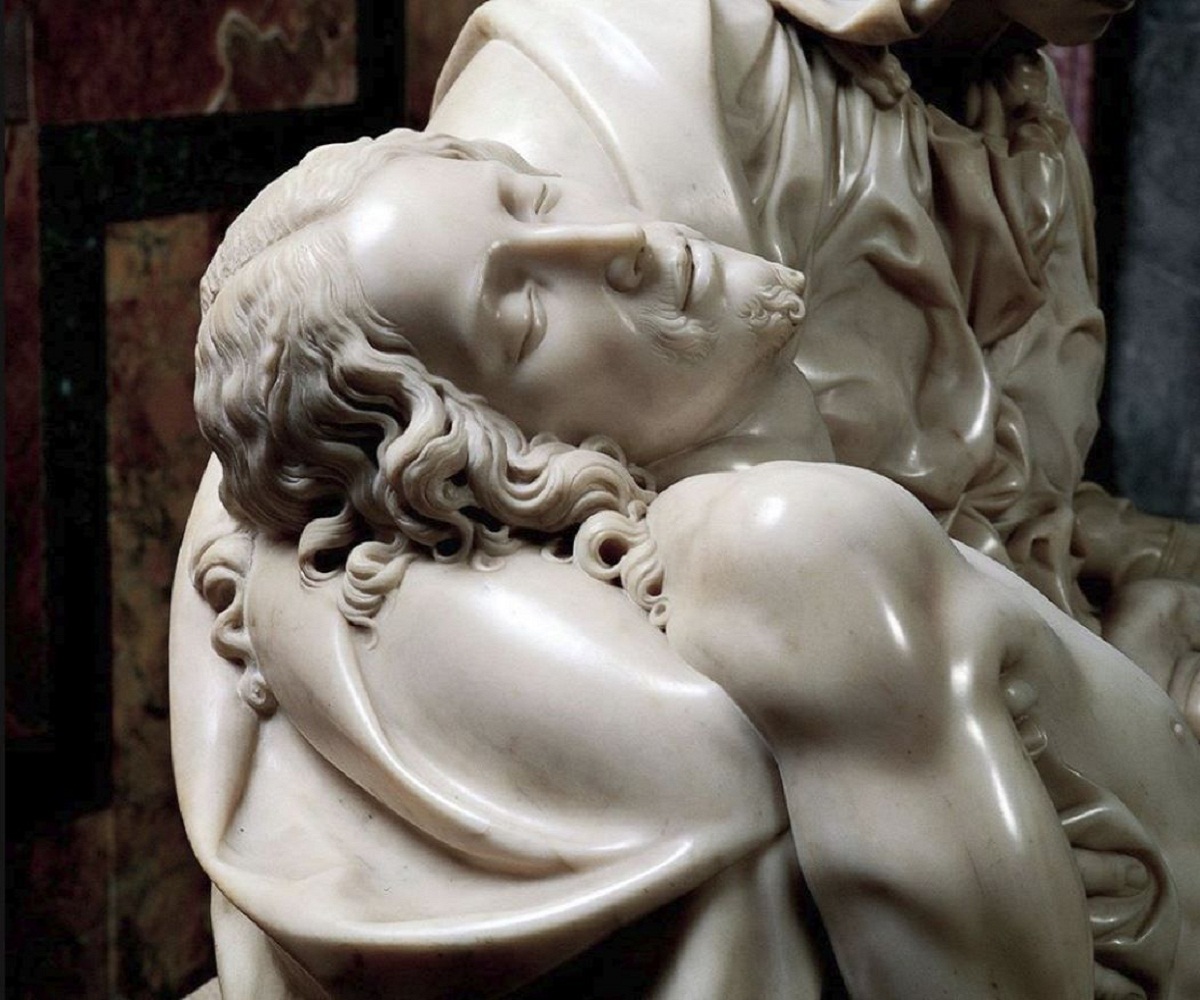In this article I invite you to know a lot of information about the sculpture known as La Piedad by Michelangelo. The most famous sculpture in the world and has a lot of bastion for being a unique sculpture. Although in 1972 she was attacked by a person who disfigured the Virgin Mary, keep reading to learn more about the sculpture!

La Piedad
The sculpture known as The Vatican Pietà was made between 1498 and 1499. By the Renaissance painter Michelangelo. When he was 24 years old. Michelangelo's Pietà sculpture. It describes the figure of the Virgin Mary holding the body of her son Jesus of Nazareth already dead at the crucifixion.
The famous sculpture La pieta has dimensions of 174 centimeters high by 195 centimeters wide. Today we can find it behind a bulletproof glass wall in the Chapel of the Crucifix inside St. Peter's Basilica in Vatican City.
History of Michelangelo's Pietà
The sculpture of piety made by the Renaissance artist Michelangelo was commissioned by the Cardinal of Saint Denis, whose real name was Jean Bilhères de Lagraulas or de Villiers, a Benedictine. Who served as the ambassador of the French monarch in the Vatican City within Rome.
Between Cardinal Saint Denis and the Renaissance painter Michelangelo they signed a contract on August 26, 1498. The payment stipulated that the painter Michelangelo would receive the amount of 450 ducats in gold. But the work had to be ready in less than a year.
In effect, this happened before the year was over, since there were only two days left, the work was already finished. Although Cardinal Saint Denis had died a few days ago without being able to see the completed work. Therefore, the first place that the Pietà had as a center of settlement was the tomb of Cardinal Saint Denis.
The Cardinal was buried in the Chapel of Santa Petronila located in Vatican City. The sculpture of Pietà remained there for a long time. Until the decision was made to move it between 1749 and 1750. Since the exact date is not known and since then its current location has been the Basilica of Saint Peter in the well-known Chapel of the Crucifixion on the right.
Description of the Sculpture
The Pietà sculpture is what art specialists call a round bulge since the sculpture can be seen from all angles. But the best way to see the Pietà sculpture is from the front view.
The sculpture is made up of the Virgin Mary and Jesus of Nazareth. The 24-year-old young artist Michelangelo sculpted the Virgin Mary very young and beautiful. Also very pious. She wears a dress that has numerous folds that expand throughout the sculpture.
The Virgin carries Jesus of Nazareth in her arms, who is already dead from the crucifixion they did to him. The sculptor Michelangelo recreated the Virgin Mary younger than her son, Jesus of Nazareth. He though he did it intentionally to make Jesus look older than the Virgin Mary.
The sculpture of the Pietà is framed in what is called a very calm triangular composition so that the Virgin Mary carries her deceased son in her arms. Although the Renaissance painter Michelangelo shows the Virgin Mary in sculpture younger than Jesus of Nazareth since it is Renaissance idealism.
Where it was tried to represent the Virgin Mary. As the center of beauty and youth, that is, an eternally young and beautiful mother. Giorgio Vasari himself, who is considered the first art historian, commented on the sculpture of the Pietà as follows:
“It is a work to which no excellent craftsman can add anything in drawing, or in grace, or, no matter how much they tire themselves, in strength, in power of fineness, smoothness and chiselling of marble”
It is important to highlight the sculpture of the Pietà. That the Renaissance painter Michelangelo took iconographic work very seriously, that later with time and his experience he repeated it in several of his great works. That revealed his great intelligence and artistic and spiritual evolution.
The last of his works that has to do with the theme of piety. It was the well-known Rondanini Pietà, which has been considered the last work sculpted by the Renaissance painter Michelangelo before he fell ill and died. Although he could not finish it since he spent six days working on that project and died, this work remained unfinished.
At the time that the artist Miguel Ángel took the job to make the sculpture of Pietà, he was 24 years old, but before that he had dedicated himself to making a full-body figure of the Virgin Mary together with Jesus of Nazareth fallen on his knees. piece was left without details.
When it was his turn to make the sculpture of Pietà. The Tuscan artist himself decided to go to the quarries where the material was extracted in the Apuan Alps of the city of Tuscany and himself choose the piece of marble with which he sculpted the figures, among them was the Pietà.
Although the same historian Giorgio Vasari, came to affirm that the Renaissance artist chose the pieces of marble and then removed the parts that were left over until he could make the sculpture. Since in the block of marble there was already what was needed or the piece that he wanted to sculpt. Because according to the Renaissance painter he could see with the intellect what was in the piece of marble.
In the case of the Pietà sculpture, the artist was able to observe the pain of a mother when she loses her only son or is killed. In addition, what an artist may need is technique to be able to carry out the work. Also of having an unbreakable patience to be able to do it again when something fails.
When the work was completed, the artist was going to make the delivery. Many people, seeing the sculpture, began to question whether the Renaissance artist Michelangelo had been able to make a tremendous statue in marble, which meant that due to his youth, he could not be able to make the sculpture. Piety.
When the Renaissance artist found out what was said that he had not been able to make said sculpture. He was filled with a lot of rage, he went to where the sculpture was, he took the chisel and the hammer and began to sign the work. It is the only work that the Tuscan Renaissance painter signed.
Michelangelo's signature was placed on a ribbon that crosses the chest of the Virgin Mary where the following can be read "Michael A[n]gelus Bonarotus Florent[inus] Facieba[t] “which translated into Spanish means Miguel Ángel Buonarroti, Florentine, did it.
Sculpture Characteristics
The sculpture is known as the Vatican Pietà but many also know it as Michelangelo's Pietà. As already said, it is a figure with a circular shape where the Virgin Mary is represented and her son, Jesus of Nazareth, already murdered, rests on her arms. This fact is known as the lamentation of the dead Christ.
Among the main characteristics that can be found and observed on the sculpture of Michelangelo's piety. They are the material, the treatment of the composition, the figures and the dimensions:
Material: Michelangelo's piety sculpture is made in what is called a monolithic piece. That means that the artist made it from a single block of marble that he himself chose when he went to the quarries in the Alps in his hometown of Tuscany.
Since the story that is told was that the artist. he decides to go looking among the different quarries for the piece of marble that he was going to use to be able to sculpt the work of Pietà. In one of the quarries he observed in a vein a piece of marble paler than normal.
In this way, the artist ordered that block of marble, which was paler, to be removed. He used it to be able to carry out the work that today has been on display for more than 500 years. It has been one of the most important pieces of the Renaissance artist Michelangelo.
This also gives a certain explanation to the sculpture of the Pietà by Michelangelo. Where the structure has a very uniform appearance and the veining of the block does not interfere with the representation of the Virgin Mary and Jesus of Nazareth already killed.
Size: the sculpture known as the Pietà by Michelangelo. It is a work that is about 195 centimeters wide and 174 centimeters high. Therefore, it is inferred that the artist created a life-size sculpture or at a scale of one to one. In order that the public spectator of the work can feel what a mother feels when seeing her son murdered.
Composition: the work is characterized by a set of specialists in art. Like what is called round or whole. Because it houses more than one figure, in this case there are two, the Virgin Mary and Jesus of Nazareth. While when it is full-length it is because the piece can be admired from different angles and the observer can feel what the sculpture could be feeling in a figurative sense.
Although it should be noted that the sculpture of the Vatican Pietà is based on the geometric figure of the equilateral triangle and is on an elliptical base. In this way the sculpture is endowed with great balance and tremendous stability.
Figures: among the figures that stand out in the work Pietà made by the Renaissance painter Michelangelo, which are the Virgin Mary and Jesus of Nazareth. The following can be said:
Jesus of Nazareth his figure is on the legs and arms of the Virgin Mary, both his head and his right arm are slightly inclined to the right side and this makes a harmony with the Virgin Mary who is dressed in a set of fabrics that when you look at them you see that they are very thick and there are many folds in that type of clothing.
According to what the artist Michelangelo revealed about what he wanted to represent of Jesus of Nazareth, it is that he was a man with a human nature. Which is why when he is killed he was a dead wreck. That is why no gesture of pain is seen in the figure of Jesus of Nazareth.
The virgin Mary: the figure of the Virgin Mary in relation to her only son Jesus of Nazareth in the Pietà sculpture. It is an element whose function is optical correction in order to give a balance to the sculpture. Since the proportions that the Renaissance artist gave it are closely related to the leading character of the figure of the Virgin Mary. Since the figure of the Virgin Mary is the center of public attention.
That is why the Virgin Mary is holding Jesus of Nazareth between her arms and legs when he has already been killed by his executioners on the cross of Calvary. She has her left hand raised as if making a prayer to God himself for the soul of her dead son.
Like Jesus of Nazareth, the face of the Virgin Mary shows no feeling for the loss of her son. Although the direction of her head is turned downwards, it makes the viewer think that the Virgin Mary is very sad because of what happened to her only son, Jesus of Nazareth. She is like meditating before the situation that happened.
Model and Technique: The painter Miguel Ángel, who was 24 years old when he finished the Pietà sculpture, draws a lot of attention from the public viewing the work. As well as specialists in the area of art that being a single piece of marble it has several textures and the modeling of the work was very thorough. Therefore, different forms of modeling can be observed.
When the artists Michelangelo. He focused his technique on making the folds of the dress worn by the figure of the Virgin Mary, since the upper part of the folds have been more treated and polished than the folds of the lower part. This causes the light to be placed with greater intensity in the upper part and in this way creates more delicacy in the sculpture of the piety.
The artist's signature
Although a little about the signature he made has already been reviewed in this part of the article. We will give you more information about why the young 24-year-old artist decides to sign his work once it is finished and it is the only work that the Renaissance artist Michelangelo signed in his entire life.
In the book that Giorgio Vasari wrote. The first known art historian tells an anecdote in a book he wrote entitled The Lives of the Most Excellent Italian Architects, Painters, and Sculptors.
Where the artist Michelangelo had already completed the sculpture of the Pietà. A rumor was spreading throughout the town. That the painter and sculptor known as Gobbio, from Milan, had spent a year sculpting a great work known as the Vatican piety.
That is why to avoid further complications the Tuscan painter Michelangelo had had. He decides to go get the chisel and hammer from him and sign the work. The painter was very upset by the rumor that was spreading. That is why he places his signature on the ribbon that crosses the Virgin Mary's chest.
sculpture analysis
The sculpture known as the Vatican Pietà. It is a piece of more than 500 years that will represent the devotion and what the Virgin Mary regrets when she sees the body of her son already dead. After she died on the cross. Although this scene is not mentioned in the bible and in any gospel.
That is why the scene began to be recreated at the beginning of the XNUMXth century. But it was performed to the private devotion of some people. Although many of the artists were based on the prophetic verses about the suffering that the Virgin Mary had to go through when observing her only son dying on the cross of Calvary.
Attack on the Pietà sculpture
In the year of 1972 on May 21. The sculpture known as the Vatican Pietà. She is attacked by a person of Hungarian origin. Who was known as an Australian geologist by the name of Laszlo Toth. This man climbed where the Pietà sculpture was placed and in a short time he gave the sculpture 45 blows with a hammer.
The hammer blows were given to the face of the Virgin Mary, whose nose was removed. She also broke the left arm of the Virgin Mary and Jesus of Nazareth broke one of her legs.
According to the account of the people who lived through the event, the geologist said that he was the only Jesus and the son of God. The eyelids of the Virgin were also destroyed by the strong hammer blows that the attacker gave to the sculpture.
After having arrested the perpetrator of the hammer blows and put him in jail to dictate a trial for what he did. The Vatican took action on the matter in order to begin the restoration of the sculpture known as The Vatican Pietà.
While they were discussing how to restore the sculpture. They realized that there were some Vatican archives where it is shown that there is a faithful copy of the Vatican Pietà. This was to the north of Bolivia with a border with the Peruvians. That's why they sent a group of specialists there.
It was verified that there was an equal copy of the Pietà sculpted by the Renaissance artist Michelangelo. Those sent by the Vatican realized that there is not only one but two, a black one made of aluminum to make it lighter and another white one made of plaster, this one had to be destroyed.
But the Peruvians did not. The plaster sculpture or the white one which had to be destroyed. It was the one that the engineers and architects sent by the Vatican took the exact measurements to be able to restore the original sculpture by Michelangelo.
In this way, another mystery around Michelangelo's piety is revealed. How was it that the senator of Peruvian origin was able to convince Juan XXIII in the year 1960. So that he would agree to be able to make an exact replica of the sculpture of Michelangelo's piety. Since the Pope was against copying the Vatican sculptures. Something that is unique in the world are the works of Michelangelo, including the Pietà.
While the person who gave the 45 hammer blows to the work La Piedad. She was confined to an insane asylum for a year. Since she came to say that he was her. Jesus of Nazareth. After recovering she lived in Australia and could not go to Italy anymore and less to the Vatican City.
If you have found this article on Michelangelo's Pietà important, I invite you to visit the following links:
